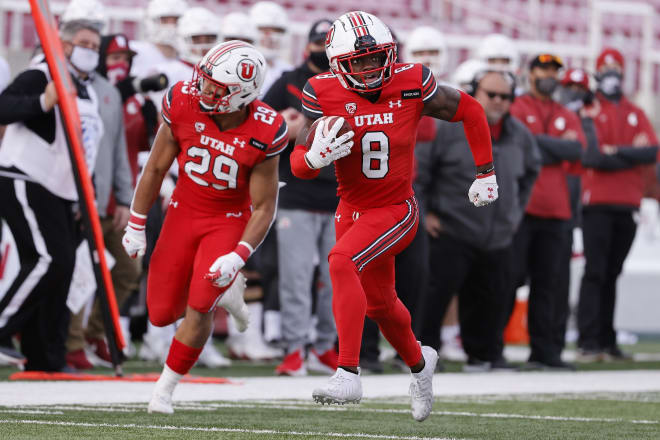Burning Question: Heading to the Offseason
JOIN THE CONVERSATION TODAY
Premium Access Free trial until 01.29.21
Promo Code: UtesNSD
Valid to 01.01.21


We’ve seen the last of the 2020 Utah Utes, as they wrapped up their campaign with a thriller 45-28 victory over Washington State. Despite being bowl eligible, the players decided to opt out of a postseason game and return home for the holiday season after a grueling, albeit short slate of games. That game would have been the Independence Bowl in Shreveport, Louisiana.
Now, the Utah coaching staff will look to prepare for the 2021 season—and they are already off to a hot start. As we gear up for the New Year, let’s take one last look at this wild, weird season and gear up for an exciting run in 2021.
Last Week’s Questions
Can Jake Bentley control the ball and get it to the playmakers?
You really have to feel for Jake Bentley. He transfers to Utah with the hopes of taking over the starting gig, loses it to Cameron Rising, and is thrust back into the QB1 role only to be sidelined yet again in the season finale. It wasn’t as if he wasn’t given ample chances to prove himself, but man, what a rough spell for the guy.
Against Washington State, Bentley fumbled (recovered by Utah) and threw a head-scratcher interception in the second quarter, which was all Kyle Whittingham could take, turning to former walk-on Drew Lisk for the remainder of the game.
Lisk walked on at Utah in 2017 and not long after, earned a scholarship. Since then, his most notable contribution to date was the Troy Williams shoe game, when, in a classy move, Williams faked a flat tire and took off his cleat to give Lisk some reps.
The Washington State game will forever go down as the Drew Lisk Game—he finished the day going 15 for 26 for 152 yards (5.8 average), no touchdowns, no interceptions and a QBR of 42.9. Not exactly lights out, but he ignited the spark within his teammates to come back from a 28-7 deficit to win by 15. They believed in Lisk.
Will Micah Bernard have a larger role?
Last week, the news was about the transfers of Jordan Wilmore and Devin Brumfield. That left just Micah Bernard to back up Ty Jordan, though Jordan didn’t need much backing up. Jordan saved his best game as a freshman for his last, going for 154 yards on just 22 carries (7.0 average), 33 yards through the air and three touchdowns. Jordan is the first Ute freshman to rush for three-straight 100+ yard games since Chris Fuamatu-Ma’afala in 1995.
On Tuesday, Jordan was named Pac-12 Offensive Freshman of the Year. He also has a case to be the latest Ute to make the Freshman All-American team since teammate Britain Covey in 2015. Jordan is the top freshman rusher in all of college football, rushing for 119.4 yards per game (9th overall). His 144.6 all-purpose yards per game are top among freshmen (20th overall), and his 7.19 yards per carry are 2nd in the Pac-12 and 11th in college. It’s scary to imagine those numbers for Jordan, as a season-long starter.
Jordan’s 22 carries are right in his wheelhouse. The Utes had six other rushers who went for 69 yards, including 15 yards from Bernard. The Utes felt they had the advantage on the edges—there were a few tight end sweeps to Brant Kuithe (33 yards) and another jet sweep to Bryan Thompson for a touchdown. In 2021, if Jordan needs a breather, Bernard is more than capable of replacement snaps.
Will the Utes win the turnover battle?
The Utes coughed up the ball three times in the first half, giving Washington State prime field position. Samson Nacua and Ty Jordan fumbled and Bentley threw an interception. In the second half, the defense stepped up and the offense locked in—Nephi Sewell, Devin Kaufusi and Clark Phillips III recovered fumbles, and Phillips III recorded his first collegiate interception, a pick six to boot.
It’s such a simple concept. More often than not, you win the turnover battle and you win the game. The Utes won the turnover battle, essentially doubling the amount of possessions as Washington State in the second half, priming them for the unbelievable comeback.
Burning Questions: Offseason
Who lines up as QB1?
Kyle Whittingham is not messing around. He’s in “win now” mode and proved it by bringing in two transfer quarterbacks in less than 24 hours.
The first to commit was Texas redshirt freshman Ja’Quinden Jackson, a 2020 recruit that was the no. 5 dual-threat quarterback in the nation (no. 180 nationally). Jackson is a 6-foot-2, 232 pounder considered one of the top athletes in the entire 2020 recruiting class. His senior year, he partially tore his ACL, but he was available to play in 2020. Part of his reasoning for transferring is that he wants to play quarterback (Texas wanted him to switch positions) and he is a good friend of Ute Ty Jordan. That being said, he’s open to whatever opportunity at Utah.
The latest newcomer is Charlie Brewer, a graduate transfer from Baylor. Brewer started all four years in Waco, throwing for 9,700 yards and rushing for 1,039 yards. The 6-foot-1, 210 pound Brewer finished his Baylor career with 65 touchdowns and 28 interceptions and a career 138.1 QBR. He also added 22 career touchdowns on the ground. Quite obviously, he will be the most experienced signal-caller in Andy Ludwig’s quarterback room.
Finally, the Utes will add true freshman Peter Costelli, who just signed with Utah in the class of 2021. Costelli, a four-star quarterback from Mission Viejo HS (Cali.), was the no. 10 pro-style quarterback in this recruiting cycle (no. 218 overall) and accumulated 15 offers. Costelli wasn’t able to play his senior season due to the pandemic, though he is working on joining the Utes this spring.
Utah fans are already familiar with returning quarterbacks Cameron Rising and Cooper Justice. Rising was named the starting quarterback at the onset of this season, though played just 12 snaps before he suffered a season-ending shoulder injury on his throwing atm during an attempted fumble recovery. He had surgery to repair his shoulder, and the staff is optimistic that Rising will be fully recovered by fall camp.
The Utes will have a wealth of quarterbacks in 2021. Cameron Rising could still take the reins, but how much of an effect will it have on him taking essentially three years off of real game experience? He redshirted a year at Texas, sat out in 2019 at Utah, and missed 2020 with an injury. The last time he played a full season was in 2016. Still, the job is his until he gets bested for it.
Additionally, good luck to Bentley, wherever he ends up transferring to. Great person, good leader, it just never seemed to be a seamless fit.
Can we see a resurgence of Sack Lake City from the defensive line?
The Utes had a total of 10 sacks in 2020—in a five game season, that’s a pretty impressive number. However, four of them came from outside the front four. Linebacker Devin Lloyd had two sacks and safeties Nate Ritchie and Vonte Davis each recorded one.
Among the linemen, Mika Tafua led the Utes with three. Hauati Pututau had two sacks, and Devin Kaufusi one. The defensive ends seemed to leave a bundle of sacks on the table, just missing by a hair here or there. A true pressure from the ends on the quarterback will create havoc for opposing quarterbacks, who had too much time to work with this year.
Will starting a core of youth on the offensive line and secondary pay off?
The Utah coaching staff started a number of true and redshirt freshmen among their offensive line and secondary. Among the secondary, we won’t see Nate Ritchie for another two years. Among the corners, Clark Phillips III and part-time starter Faybian Marks took great strides as the season progressed. And don’t forget sophomore starter JaTravis Broughton.
In the trenches, Utah started and played a variety of different linemen to try and find the best five on the field. Underclassmen Jaren Kump, Sataoa Laumea and Keaton Bills saw a lot of playing time, mixing in with upperclassmen Nick Ford, Simi Moala and Orlando Umana, though Umana was hampered with injury throughout the shortened season. There was definitely a lot of growing pains among the offensive line and secondary, but they will likely pay dividends in the years to come.
